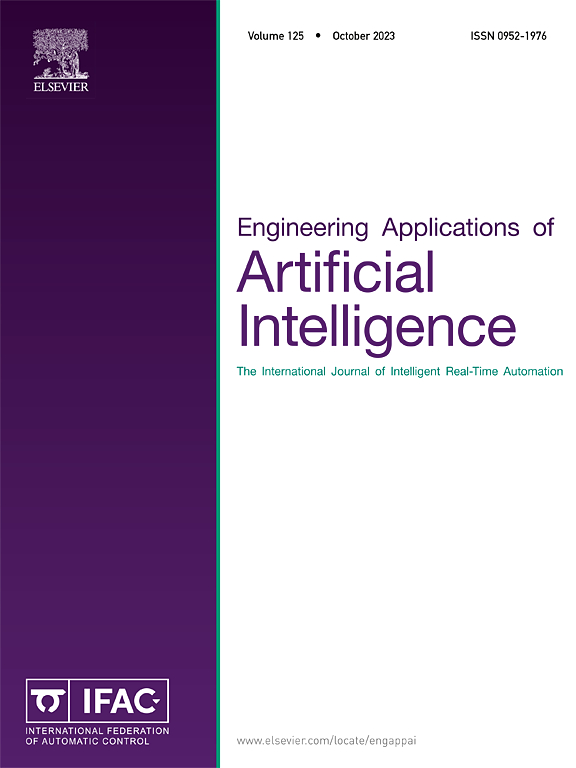Convolutional neural networks for accurate and robust noninvasive pressure measurements in sealed systems
IF 7.5
2区 计算机科学
Q1 AUTOMATION & CONTROL SYSTEMS
Engineering Applications of Artificial Intelligence
Pub Date : 2025-07-26
DOI:10.1016/j.engappai.2025.111729
引用次数: 0
Abstract
Accurate noninvasive pressure measurement in sealed systems is essential for many applications in process control, chemical transport, and chemical safety assessment. This paper introduces a pioneering approach to enhance pressure estimation using Acoustic Resonance Spectroscopy (ARS), a promising technique that analyzes the system's exterior vibrations to infer internal pressure. Despite its potential, extracting precise measurements from noisy ARS data remains challenging. We present a novel method employing a convolutional neural network (CNN) to improve the accuracy and generalizability of the pressure prediction. The CNN performance is compared against benchmark ARS processing methods such as k-nearest neighbors (kNN) and a peak tracking method. The models were trained and tested using labeled data from laboratory-controlled tests on vacuum vessels subjected to varying internal pressures. Evaluation under various signal processing and field measurement scenarios was conducted to assess the accuracy and generalizability of the proposed models. The CNN outperformed other models by significant margins, achieving a mean absolute error (MAE) of approximately 15 Torr, compared to approximately 30 Torr for kNN and 60 Torr for peak tracking. Furthermore, we tested the generalizability of the models by introducing synthetic data augmentations such as spectrum shift and dropout, which approximate real-world measurement errors in ARS measurements. We found that the CNN maintained high accuracy under shifting and dropout data scenarios, showcasing its robustness, while the other models showed larger increases in error. This suggests CNN as a strong candidate for noninvasive pressure measurements, as well as a wide range of other applications detectible via spectral measurements, such as corrosion detection, structural integrity monitoring, or reaction tracking in closed vessels, offering high accuracy and resilience to environmental fluctuations.
卷积神经网络用于密封系统中精确、稳健的无创压力测量
密封系统中精确的无创压力测量对于过程控制、化学品运输和化学品安全评估等许多应用至关重要。本文介绍了一种利用声共振光谱(ARS)来增强压力估计的开创性方法,这是一种很有前途的技术,通过分析系统的外部振动来推断内部压力。尽管具有潜力,但从嘈杂的ARS数据中提取精确测量仍然具有挑战性。本文提出了一种利用卷积神经网络(CNN)提高压力预测精度和泛化性的新方法。将CNN的性能与基准ARS处理方法(如k近邻(kNN)和峰值跟踪方法)进行比较。模型训练和测试使用标记数据从实验室控制测试真空容器受到不同的内部压力。在各种信号处理和现场测量场景下进行了评估,以评估所提出模型的准确性和泛化性。CNN的表现明显优于其他模型,平均绝对误差(MAE)约为15 Torr,而kNN的平均绝对误差约为30 Torr,峰值跟踪的平均绝对误差为60 Torr。此外,我们通过引入谱移和dropout等合成数据增强来测试模型的泛化性,这些数据增强近似于ARS测量中的实际测量误差。我们发现CNN在移位和丢失数据场景下保持了较高的准确率,显示了其鲁棒性,而其他模型的误差增加较大。这表明CNN是无创压力测量的有力候选者,以及通过光谱测量可检测的广泛其他应用,例如腐蚀检测,结构完整性监测或封闭容器中的反应跟踪,具有高精度和对环境波动的弹性。
本文章由计算机程序翻译,如有差异,请以英文原文为准。
求助全文
约1分钟内获得全文
求助全文
来源期刊

Engineering Applications of Artificial Intelligence
工程技术-工程:电子与电气
CiteScore
9.60
自引率
10.00%
发文量
505
审稿时长
68 days
期刊介绍:
Artificial Intelligence (AI) is pivotal in driving the fourth industrial revolution, witnessing remarkable advancements across various machine learning methodologies. AI techniques have become indispensable tools for practicing engineers, enabling them to tackle previously insurmountable challenges. Engineering Applications of Artificial Intelligence serves as a global platform for the swift dissemination of research elucidating the practical application of AI methods across all engineering disciplines. Submitted papers are expected to present novel aspects of AI utilized in real-world engineering applications, validated using publicly available datasets to ensure the replicability of research outcomes. Join us in exploring the transformative potential of AI in engineering.
 求助内容:
求助内容: 应助结果提醒方式:
应助结果提醒方式:


